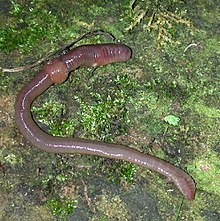Worm
| Worms | |
|---|---|
 |
|
| Lumbricus terrestris, the common earthworm | |
| Scientific classification | |
| Kingdom: | Animalia |
| Subkingdom: | Eumetazoa |
| (unranked): | Bilateria |
| Phyla | |
|
|
Worms /ˈwɜːrm/ are many different distantly related animals that typically have a long cylindrical tube-like body and no limbs. Worms vary in size from microscopic to over 1 metre (3.3 ft) in length for marine polychaete worms (bristle worms), 6.7 metres (22 ft) for the African giant earthworm, Microchaetus, and 58 metres (190 ft) for the marine nemertean worm (bootlace worm), Lineus longissimus. Various types of worm occupy a small variety of parasitic niches, living inside the bodies of other animals. Free-living worm species do not live on land, but instead live in marine or freshwater environments, or underground by burrowing.
In biology, "worm" refers to an obsolete taxon, vermes, used by Carolus Linnaeus and Jean-Baptiste Lamarck for all non-arthropod invertebrate animals, now seen to be paraphyletic. The name stems from the Old English word . Most animals called "worms" are invertebrates, but the term is also used for the amphibian caecilians and the slow worm Anguis, a legless burrowing lizard. Invertebrate animals commonly called "worms" include annelids (earthworms and marine polychaete or bristle worms), nematodes (roundworms), platyhelminthes (flatworms), marine nemertean worms ("bootlace worms"), marine Chaetognatha (arrow worms), priapulid worms, and insect larvae such as grubs and maggots.
...
Wikipedia
